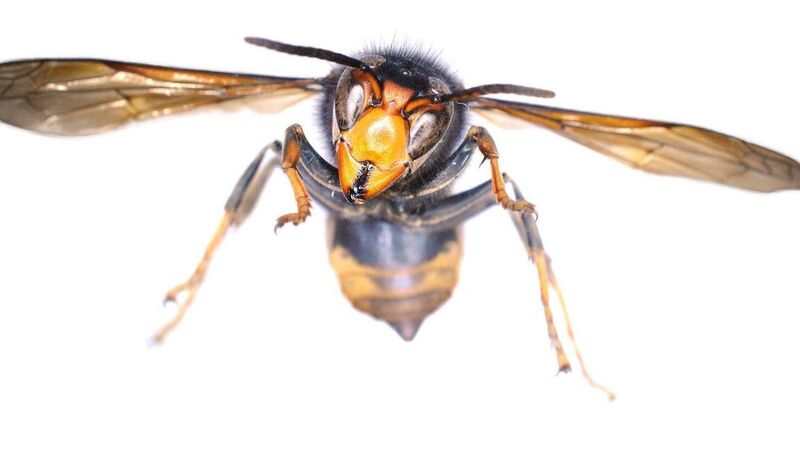What is the Asian hornet and should we be worried after one was found in Cork?

The Asian hornet is an invasive species in Europe that is a fierce predator of domestic honeybees, as well as pollinating insects. Picture: National Museum of Ireland
Following the confirmation that an Asian hornet had been found in Dublin in 2021, Cork (of course) has now got its own hornet, found in a beer garden (of course) in the city this month.
It has since been revealed that a nest has also been located in the city. So what’s the story?
The Asian hornet, Vespa velutina, is a large predatory wasp, larger than the common yellowjacket of summer picnic fame, but smaller than the European hornet. Its diet consists of foods rich in protein and carbohydrate, such as other insects, pollen, fruit and even carrion.
One of the reasons that there is such alarm at the spread of this invasive species in Europe is that it is a fierce predator of domestic honeybees, as well as pollinating insects. Although it can give a potentially painful sting, the Asian hornet is not particularly aggressive and poses only a minor risk to people and domestic animals, although fatalities are known (but very rare) from Asian hornet stings.
Its native range is Central and Eastern Asia, but it has become established in Europe since 2004, when a single fertilised queen arrived in France hiding in a shipment of pottery from China. From this single accidental introduction, the Asian hornet has spread throughout much of western Europe and its population is now thought to number in the many millions.
Asian hornets mate in late summer, and fertilized queens from a nest will disperse into the wider landscape in autumn looking for well-insulated nooks and crannies to hibernate in over the cold winter months, such as under the bark of trees, in small cavities – and ceramic pots! When these solitary queens emerge from hibernation in early spring, they seek to build small, primary nests in warm, sheltered places such as old abandoned buildings.
As the number of worker hornets from this primary nest grows, the queen may build a secondary nest outside, such as the tops of tall trees, and this then may number many thousands of individuals, where the main job of the nest is to produce new males and queen hornets.
Worker hornets are very active in summer searching for food and can easily find their way into lorries transporting fruit and vegetables. They are also commonly found around campsites in France, attracted by the volumes of discarded food and overflowing bins, and can hitch rides in amongst camping materials and in campervans.
The hornet in Cork most probably arrived on the ferry from northern France, via one of these routes. Fertilised queens - with the potential of establishing a population in a new area – tend to disperse in autumn looking for hibernation sites and so it is more likely that the specimen found in Cork recently was a sterile worker looking for food.
The Asian hornet is a continental species and requires warm, dry summers to thrive. Migrant queens have arrived on multiple occasions into southern England from northern France, either in freight traffic or flying across the channel with wind-assistance.
Although these queens can and do make small nests, it remains to be seen whether they will establish a permanent UK population. But could they do so here in Ireland?
It is very likely that we will see more Asian hornets arriving in the country, brought here in vehicular traffic, and some climate projections show that Ireland is within the hornet’s potential future range. The Irish climate is much more oceanic than that of southern English, and is typified by cool, wet summers and (relatively) warm wet winters.
The lack of consistent warm summers in Ireland and the relative paucity of habitat and potential food - particularly in spring when queens emerge from hibernation and need sugar-rich food to begin making their primary nests – reduce (but not eliminate) the likelihood of the Asian hornet becoming a serious problem in Ireland in the future.
Vigilance however is needed by drivers returning from the continent to prevent the Asian hornet from hitch-hiking its way to our shores. Although Irish beekeepers are well aware of the threat posed by Vespa velutina, and are constantly on the lookout, the public should keep their eyes open for the insect and report all potential sightings (with photos if possible) to the National Biodiversity Data Centre in Waterford.
Even if they see them in beer gardens.
- Simon Harrison is a lecturer at the School of Biological, Earth and Environmental Sciences (BEES), University College Cork
CLIMATE & SUSTAINABILITY HUB
















